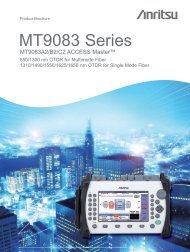User Manual DDS200 Digital Demodulation System 070-9952-00
User Manual DDS200 Digital Demodulation System 070-9952-00
User Manual DDS200 Digital Demodulation System 070-9952-00
Create successful ePaper yourself
Turn your PDF publications into a flip-book with our unique Google optimized e-Paper software.
<strong>Manual</strong> OperationEchoes must not exceed –6 dB after 1<strong>00</strong> ns and –20 dB after 2.5 s. Anyechoes occurring after 2.5 s will not be compensated.Selection of Integration Time for BER Measurement. For BER measurements, themeasurement speed and stability of display can be modified. To illustrate this,the principle of BER measurement is briefly described below.The <strong>DDS2<strong>00</strong></strong> continuously evaluates the error-correction events of the incomingDVB data stream. This is accomplished using bit-by-bit comparison of thenominal and the actual data streams. All bits of a 204-byte (1632-bit) frame arechecked for coincidence. Every deviation is counted. The counter is read after6127 frames and the count stored in a dynamic memory of 1<strong>00</strong>0 locations.Depending on the BER rate, the test depth must be adjusted. This is done byusing only the last value stored for calculating the BER or by carrying out anintegration over 10, 1<strong>00</strong> or 1<strong>00</strong>0 measured values. In BER calculation, the unitautomatically switches to a longer integration time if this is expedient. The unitswitches back automatically to a shorter integration time if this is desired by theuser.You can define a minimum number of BER samples to be taken in a measurement.If 1<strong>00</strong>0 samples are selected, for example, the test receiver operatesexclusively in the 1<strong>00</strong>0-sample mode. This also means that sufficient time mustbe allowed for a measurement to obtain a useful result. A very stable indicationis obtained with this mode, which is suitable especially for stationary applicationswhere the operating conditions for the demoduator remain the same.If a minimum integration time of 1 sample is selected, the receiver switches themeasurement time to 1 sample when a high BER (>1E-6) is measured. Incalibration, for example, this allows a change of the BER value to be detectedimmediately; however, the indication is relatively unstable due to the shortmeasurement time. In practice, a minimum integration time of 10 samples hasproven expedient for normal applications. Information on the status of integrationis useful, especially with a high number of samples. Two figures aretherefore specified together with the BER value. The first figure indicates thenumber of samples actually used for the BER value displayed; the second figureindicates the total number of samples to be achieved (for example,BER = 7.2E-9 (144/1<strong>00</strong>0)).With a typical DVB symbol rate of 6.9 Msps and 64QAM modulation, the bitrate is 41.4 Mbit/s, corresponding to 25367.6 frames per second. If the bit errorsof 6127 frames are represented by one sample, a time of 241.5 ms per sample isobtained. At the maximum integration level (1<strong>00</strong>0 samples), a measurement thustakes 241.5 s. In this case, a resolution of 0.1E-9 can be achieved for the BERvalue.<strong>DDS2<strong>00</strong></strong> <strong>Digital</strong> <strong>Demodulation</strong> <strong>System</strong> <strong>User</strong> <strong>Manual</strong> 2–79
















